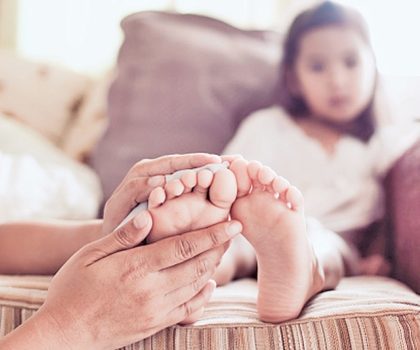Keeping the structure of the foot in kids and teens intact is the key to adult foot health

By Patricia Nugent
With Covid restrictions in the rearview mirror, it’s wonderful to see athletes and teams getting back to the fields, courts and tracks. However, parents should keep in mind that we are also heading into peak season for sports-related injuries and ailments.
“Some common issues I see in 10- to 15-year-olds affect the growth plates, which are areas of cartilage near the ends of bones that allow them to grow,” says podiatrist Dr. Danielle Shaper, founder of Finesse Footcare in Lyndhurst.
Injuries are easily detected and diagnosed in her office with a digital X-ray.
Mainly caused by repetitive stress to the heel, she says growth plate injuries often occur in sports with lots of running and jumping, like soccer, baseball and basketball, as well as dancing.
“One that I treat a lot is called Sever’s disease, which causes pain due to inflammation of the heel’s growth plate in children and adolescents,” she says.
Treatment includes a stretching regimen and resting the foot, sometimes immobilizing it in a walking boot or cast.
“If your child is complaining about heel pain, it should be checked out. Growth plate injuries can become serious if they are left untreated, affecting growth and eventually causing bone deformity,” she says.
In addition to growth plate injuries, other pediatric cases Dr. Shaper sees include warts, bunions, flat feet, hammertoes, ankle sprains and fractures.
Another frightening ailment to watch out for is Covid toe.

“It manifests in the feet of children and adolescents and almost looks like frostbite,” she says. “The toes turn a blueish color and often have red or purple lesions that are itchy or painful. In most cases the children do not present with other coronavirus symptoms, just the toes.”
She reports that this time of year especially, she’s treating kids and teens with in-grown toenails.
“Cleats and tight-fitting track spikes can put extra pressure on the toes,” she says.
Whatever the sport, Dr. Shaper says she can save an athlete pain or injury in the long run if she can prescribe a special stretching regimen for his or her activity level.
“Also, custom orthotics can help ease the impact and align the feet through growth spurts, when they might be more susceptible to growth plate injuries,” she says.
“And with many athletes, low dye taping can be worthwhile.”
Effective Fungus Treatment
Dr. Shaper says she’s seeing younger patients who are experiencing toenail fungus.
“I treat lots of kids as early as 10 or 11 years old,” she says. “I think the environmental factors, such as kids spending time in swimming pools and walking around barefoot, may be the reason. They are too young to be put on oral medication, yet you don’t want to let a toenail fungus infection go, as it will only get worse. It won’t get better on its own.”
The good news is the same Lunula laser that Dr. Shaper has been using on adults is perfectly safe for kids, too.
Finesse Footcare is located at 5035 Mayfield Road in Lyndhurst. As a full-service podiatrist, Dr. Shaper also treats most foot and ankle issues, such as ingrown toenails, bunions, heel pain, hammertoes and corns. She also offers diabetic footcare, orthotics, sports medicine and surgery, as well as basic routine foot care. The practice accepts a wide variety of insurance plans. Call 216-382-8070 or visit FinesseFootcare.com for more information.
